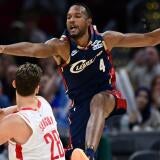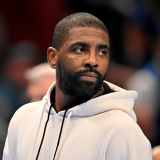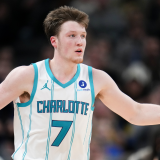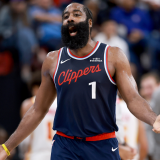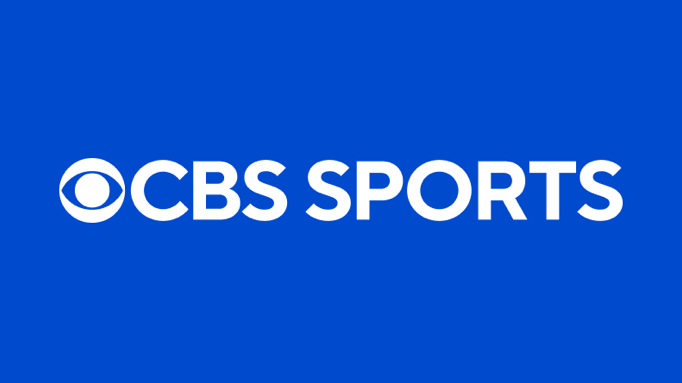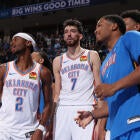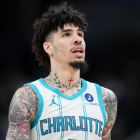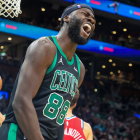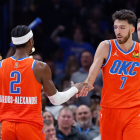
What if a genie forced the Thunder to trade everyone? Welcome to my burn-it-down spiral
We could write another love letter to the Oklahoma City Thunder (15-1) ... or we could trade their whole roster for fun

Indulge me for a moment. Every now and again, I write what I call the NBA's "blow it up" rankings, meant to rank all 30 teams by how likely they are to blow up their rosters and start over. Obviously, the bulk of these rankings are meant to cover the worst teams, the ones that badly need a reset. But we rank all 30 teams and inevitably, that means we at least address the league's best. Right now, that would be the Oklahoma City Thunder.
In no universe would the Thunder blow up their roster. You could make a compelling argument that no team in NBA history has needed a blow-up less than the 2025-26 Thunder. They're destroying the league with one of the NBA's youngest rosters. They're doing it while their second-best player, Jalen Williams, remains sidelined as he recovers from wrist surgery. They still have a mountain of future draft picks to use for future roster touch-ups. It would be irresponsible to blow this team up in 2K, let alone real life. It's not happening.
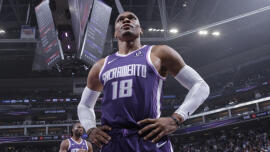
But what if they did? Let's say a rival GM found a genie and used one of his wishes to force the Thunder to blow up their team. How many first-round picks could Oklahoma City hypothetically get if it really committed that to magically induced endeavor? That thought experiment grew so exhaustive that we decided to write it down.
First, let's set a few ground rules:
- The sole goal of this exercise is to acquire as many first-round picks as humanly possible. Therefore, the value in these trades will mostly be derived from picks. The Thunder will not seek player value in exchange for those they move here, nor will they demand swap rights for picks they can't acquire outright.
- However, trades generally require matching salary. If the players the Thunder receive have value, they are within their rights to flip those players for more picks. To that end, we will be constructing basic outlines for specific trades to serve as guidelines in the salary-matching process when necessary. Should a team be in line for the cap space to acquire a Thunder player without matching salary, that will be noted.
- All of these fictional trades will take place in the summer of 2026. Why? Because Oklahoma City's three best players are all easier to trade at that point. Shai Gilgeous-Alexander literally can't be traded this season because of the extension he signed. Chet Holmgren and Jalen Williams also signed extensions and they carry standard poison pill provisions in all rookie extensions that make matching salary difficult. This means that 2026 draft picks are eligible to be traded, though they'd have players attached (the Thunder would presumably guide the team in question on who to pick for them), and picks could be traded as far out as 2033.
- Nikola Topić and Thomas Sorber are off limits. While both may be able to net first-round picks from teams that liked them in their drafts, neither has played in the NBA and both have suffered torn ACLs, so we can't really speculate on what sort of trade value they'd still have.
With all of these parameters in place, I set about blowing up the Thunder. The conclusion that I reached, in the steps you'll find below, is that the Thunder could acquire a total of 28 first-round picks by breaking up their roster. How did I get there? Join me in my attempt to break the trade machine with this absurd experiment.
Trading the stars
Shai Gilgeous-Alexander is so good and so young that if the Thunder wanted to trade him, they could feasibly pick any team's collection of draft picks they wanted in return. The team with the most valuable collection of first-round picks in the league today, the Thunder excepted of course, would be the Rockets. So our first deal sends Gilgeous-Alexander to Houston for the following:
- Phoenix's unprotected 2027 first-round pick
- The better of Brooklyn or Houston's 2027 first-round pick
- The two best out of Dallas', Phoenix's and Houston's 2029 first-round picks
- Houston's own unprotected first-round picks in 2031 and 2033
This is, obviously, the draft pick motherlode. Phoenix has overperformed thus far this season, but those two Suns picks have massive disaster potential in a loaded Western Conference. The Nets are arguably this year's worst team, so their 2027 pick is probably going to be pretty good (though, for reasons we'll soon cover, may get less valuable later in this exercise). Houston's own picks are far enough out that there's inherent upside just because we can't see the future.
And yet, there's still more to come. Houston still needs to match Gilgeous-Alexander's $40.8 million salary for next season. We'll keep their true core players out of the deal given the massive pick outlay they've already made here, but still, the easiest way to match money would involve Fred VanVleet picking up his player option and going to Oklahoma City along with Clint Capela and Reed Sheppard. VanVleet's injury and Capela's age likely preclude them from generating first-round offers, but Sheppard is a recent No. 3 overall pick on a cheap contract who is thriving right now. He'd easily net at least one, but more likely two first-round picks if he were shopped. Who needs a young guard? Nobody more than the Dallas Mavericks, who conveniently enough have their 2031 and 2033 picks to trade. They'd send those picks to the Thunder and plan their rebuild around Sheppard, Cooper Flagg and whomever they take with their 2026 pick. This takes Oklahoma City's early total to eight first-round picks.
Jalen Williams isn't quite as valuable as Gilgeous-Alexander, but to be frank, we live in a world in which Mikal Bridges got traded for five first-round picks. That's the floor for a wing who's younger and better. Of course, with Houston off the board, there just aren't that many teams left with six first-round picks to trade. Ideally, we want one that has picks acquired from another team, because the one that gets Williams will presumably be very good with him. So why not go back to the team that traded Bridges? Brooklyn fits the bill here.
To make this deal work, we'd have the Nets top the Bridges package with six first-round picks: their own in even-numbered years (2028, 2030 and 2032) and New York's in odd-numbered years (2027, 2029 and 2031). Obviously, this excludes Brooklyn's best draft asset, its ultra-valuable 2026 first-rounder. In the real world, the Thunder could credibly demand its inclusion, though at the cost of quantity on the backend. Since we're focused on maximizing quantity, we'll say the Thunder get everything except that pick, allowing the Nets to rebuild around Williams and their top 2026 pick. As the Nets are set for significant 2026 cap space, we don't need to bother with matching salary. We're now up to 14 first-round picks.
Chet Holmgren isn't quite as valuable as Williams or Gilgeous-Alexander just because of his scary injury history. However, his shooting and comfort playing power forward or center still make him exceedingly valuable, especially to teams that prefer to play with a stretch big. Two immediately came to mind. The first was Oklahoma City's 2025 Finals opponent, Indiana, who lost Myles Turner over the summer. Ultimately, it just wasn't in their character to make a trade of this nature. They'd either have to include Pascal Siakam as matching salary or gut their depth. That isn't how the Pacers operate. As you can tell, we're operating with unimpeachable fidelity to reality in this exercise of breaking up a budding dynasty.
The other obvious fit? The Bulls, who have all but abandoned rim defense in an effort to prevent 3-pointers. Holmgren would go a long way towards fixing that, and as much as Josh Giddey has improved as a shooter since he and Holmgren were teammates in Oklahoma City, his success with Nikola Vučević suggests he still really benefits from the presence of a floor-spacing center. Chicago controls all of its own picks, so we'll send first-rounders in 2027, 2029, 2031 and 2033. Additionally, Chicago has a lottery-protected first-round pick from Portland that can convey any time between now and 2028. Let's toss that in the pile as well for a total of five first-round picks, one of which is protected. The Bulls will have cap space this summer as well, though not nearly as much as the Nets. The Thunder were reportedly interested in Patrick Williams when he was a restricted free agent in 2024, so we'll use his salary to get this deal across the finish line. That's now 19 acquired first-round picks for the Thunder.
Trading the role players
OK, trading the stars was the easy part. Now comes the more tedious matter of finding deals for role players. Would any other Thunder players net multiple first-round picks in a deal? Two stand out as possibilities: Cason Wallace and, in a shocker compared to what we would have thought a month ago, Ajay Mitchell. They're both quite young, as Wallace is 22 and Mitchell is 23. They also both have very tradable contracts. Wallace will be extension-eligible next offseason but will still have a tiny $7.4 million cap figure, so almost anyone could bring him in. Mitchell has two more years at basically the minimum after this one. By declining his team option after the 2026-27 season, a new team could make Mitchell a restricted free agent and use that leverage to re-sign him on a team-friendly deal. The Thunder do this frequently with other players and almost certainly will when Mitchell's time comes in reality.
There's a very easy Wallace taker out there in Milwaukee. The Bucks have spent three years trying and failing to replace Jrue Holiday. Wallace could slide into his old job, conveniently right as Giannis Antetokounmpo weighs a possible contract extension. This could be the move Jon Horst sells to him in an effort to get him to stay: with Myles Turner replacing Brook Lopez, Wallace in for Holiday and the deep group of young guards we've signed for cheap, we can replicate our old championship forward with a new supporting cast. We'll say the Bucks trade their 2031 and 2033 first-round picks for Wallace. Kevin Porter Jr. can be used as matching salary if he picks up his player option, though Wallace's cap number is low enough to fit into the non-taxpayer mid-level exception if needed.
Mitchell is a bit harder to place. Someone out there is going to look at him as the next Jalen Brunson or Gilbert Arenas, an ascending young guard who fell under the radar because of his draft pedigree but thrived in a supporting role and is ready to be a primary ball-handler. However, we have no way of knowing which teams really believe that, so this is a shot in the dark. We're looking for a team that both needs that sort of upside because it lacks current championship equity and would benefit enough from his small salary to pay multiple picks. Toronto makes the most sense in that respect. The Raptors are playing well this season, but are already a tax team and seem more like a regular-season winner than a true contender because of their emphasis on transition and limited shooting. As of this writing, despite their 9-5 start, Toronto's starting lineup has actually been outscored by a single point through 14 games. The Raptors are winning games on the bench. So we'll have them send the Thunder their top-four protected 2027 and 2029 first-round picks, insert Mitchell as a starter, and then move Immanuel Quickley back to the bench, where he thrived in New York.
We've now traded five players for 23 first-round picks. We've ruled two more players ineligible. That leaves eight players on the roster left to consider. Ousmane Dieng has never consistently cracked the rotation, so he's not getting a first-rounder. Jaylin Williams and Kenrich Williams are useful reserves, but fall in the class of player who would get dealt for multiple second-rounders, not a single first. So we have five players left to consider, all of whom could feasibly get back a single first-round pick. Let's work our way through their trades:
- Cue the Coming Home montage because Alex Caruso is returning to the Lakers for their top-four protected 2031 first-round pick. Jarred Vanderbilt and Dalton Knecht would go back to the Thunder in this world. Rob Pelinka will never be able to undo the Russell Westbrook trade, but he can undo his second-biggest mistake here and give the Lakers the perimeter defender they need.
- The Pelicans are going to need a defense-first center next to Derik Queen. Why not Isaiah Hartenstein? New Orleans could kill two birds with one stone here and use Dejounte Murray, whose contract they'd probably like to dump, as the matching salary. They'd have to give up a pretty valuable pick to get the Thunder to take it, but don't worry, Pelicans fans, we'll at least slap a top-four protection on this 2028 selection to get the deal across the finish line.
- Lu Dort could fit on any team that needs perimeter defense, so the Thunder would prioritize getting a pick with some upside. Let's send him to Charlotte, a team with plenty of offensive upside that badly needs a stopper. The Hornets could send back Miami's 2027 first-round pick, which may be lottery protected, but becomes unprotected in 2028 if it doesn't convey in 2027. Josh Green will go to the Thunder as well as the primary matching salary.
- Aaron Wiggins is a solid two-way wing capable of starting, but his real value is derived from his contract. He's owed less than $26 million total between the 2026-27 and 2028-29 seasons. That's three years of starter-level play at a backup's price, so we want a cash-strapped team to swoop in here to steal him. How about Indiana? The Pacers have a decision to make with impending restricted free agent Bennedict Mathurin. In Wiggins, the Pacers could nab a far cheaper replacement for their bench and then either sign-and-trade Mathurin or let him walk if his offer sheet gets high enough. Let's say Indiana sends Isaiah Jackson and its lottery-protected 2027 first-rounder in this deal in order to assure another season below the luxury tax line.
- Isaiah Joe is right on the "could be traded for a first-round pick" borderline. This is an archetype that frankly hasn't net a first-round pick in a few years. The closest analogue would probably be Kevin Huerter going to Sacramento, and that was all the way back in 2022. However, what Joe has over Huerter and many peers is his salary. He'll make less than $23 million combined for the 2026-27 and 2027-28 seasons, so he's more affordable to a shooting-needy team than other specialists have been in recent years. Really, we're looking for a late first-round pick from a team with a specific need. How do the Jazz sound? They rank seventh in the NBA in 3-point attempts per game, but 26th in conversion percentage. They want to hoist 3s and, even if you assume Brice Sensabaugh bounces back to where he was last year, they could still use another sharpshooter to nudge them in that direction. They have a top-four protected Lakers pick in 2027 that seems reasonable here. With Luka Dončić in place, that pick should be in the 20s. The Jazz have cap space, so we don't need to concern ourselves with matching salary.
Where would this leave the Thunder?
So there you have it. Through our entirely scientific and in no way subjective measurement, the Thunder could trade their entire team for 28 first-round picks. The exact number of first-round picks they'll have between now and 2033 in reality will depend on protections, but could be as high as 14. Therefore, with this sequence of hypothetical moves, the Thunder would set themselves up to potentially make 42 first-round picks in the next eight drafts, or an average of just over five per draft. Enjoy this ridiculous chart of fictional draft assets the Thunder would control after making these ludicrous trades:
| Year | First-round picks controlled by Thunder |
|---|---|
2026 | Two most favorable of own, LAC and HOU (top-four protected); PHI (top-four protected); UTA (top-four protected); POR (lottery-protected); CHI |
2027 | Two most favorable of own, LAC and DEN (top-five protected); Most favorable of HOU and BRK; PHO; NYK; LAL (top-four protected); TOR (top-four protected); MIA (lottery-protected); IND (lottery-protected); SAS (top-16 protected); |
2028 | More favorable of Own or DAL; CHI; BRK; NOP (top-four protected) |
2029 | Own; Two most favorable of PHO/HOU/DAL; TOR (top-four protected); DEN (top-five protected); NYK |
2030 | Own; BRK; CHI |
2031 | Own, HOU, DAL, MIL, NYK, LAL (top-four protected) |
2032 | Own, BRK, CHI |
2033 | Own, HOU, DAL, MIL |
We have somehow constructed a world in which the Thunder could have as many as 10 first-round picks in the 2027 NBA Draft. That seems like an appropriate way to conclude this descent into madness. The Thunder absolutely will not and should not engage with this genie. But hey, for the fake traders among us, it's a fun little thought experiment.




